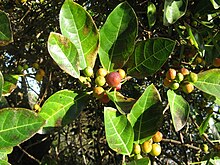Ficus fraseri
| Ficus fraseri | |
|---|---|

| |
| Scientific classification | |
| Kingdom: | Plantae |
| Clade: | Tracheophytes |
| Clade: | Angiosperms |
| Clade: | Eudicots |
| Clade: | Rosids |
| Order: | Rosales |
| Family: | Moraceae |
| Genus: | Ficus |
| Subgenus: | F. subg. Sycidium |
| Species: | F. fraseri
|
| Binomial name | |
| Ficus fraseri | |
| Synonyms | |
| |
It grows as either a shrub or tree with height ranging from around 6 to 15 metres.[6][7] Its leaves are 6 to 14 cm long and 2.5 to 6.5 cm wide on petioles that are 1 to 2 cm long.[6] The rounded figs are 1 to 1.5 cm long and start out yellow in colour, maturing to orange-red between May and February in the species' native range.[6] They are edible, but insipid.[8]
In Australia, the species occurs from Tuggerah Lake in New South Wales, northwards to the Atherton Tableland in Queensland,[6][7] and rarely in the Northern Territory.[4]
The grey-headed flying fox feeds on the figs.[9]
Although rarely seen in cultivation, it is a fast-growing, ornamental species that can be easily propagated from seed.[7]
Distribution
Chew[4] states that F. fraseri is found in the Northern Territory, a statement repeated by Govaerts et al.[3] However, Harden (1990)[6] gives New South Wales and Queensland as the only Australian states where it is found, and the collection locations are restricted to these two states for specimens recorded in the Australasian Virtual Herbarium and the Global Biodiversity Information Facility (in addition to New Caledonia in the latter case), as shown on their distribution maps.[10][11]
Taxonomy
It was first described by Miquel in 1848.[2]
References
- ^ a b "Ficus fraseri". Australian Plant Name Index (APNI), IBIS database. Centre for Plant Biodiversity Research, Australian Government.
- ^ a b Miquel, F.A.W. in Hooker, W.J. 1848. "Prodromus Monographiae Ficuum. London Journal of Botany 7: 235". Retrieved 21 May 2018.
- ^ a b c Govaerts, R. et al. 2018. "Plants of the World online: Ficus fraseri". Board of Trustees of the Royal Botanic Gardens, Kew. Retrieved 21 May 2018.
- ^ a b c Chew, W.-L. 1989. "Flora of Australia online: Ficus fraseri". Data derived from Flora of Australia volume 3, ABRS, ©Commonwealth of Australia. Archived from the original on 21 May 2018. Retrieved 21 May 2018.
- ^ "Ficus fraseri". Endémía – Faune & Flore de Nouvelle-Calédonie. Archived from the original on 16 July 2011. Retrieved 12 July 2008.
- ^ a b c d e "Ficus fraseri Miq". PlantNET – New South Wales Flora Online. Royal Botanic Gardens & Domain Trust, Sydney Australia. Retrieved 10 July 2008.
- ^ ISBN 0958943605.
- ISBN 0207169306.
- ^ "Diet list for Grey-headed Flying-fox Pteropus poliocephalus" (PDF). Australasian Bat Society Inc. July 2001. Archived from the original (PDF) on 31 August 2007. Retrieved 12 July 2008.
- ^ "AVH occurrence map: Ficus fraseri". Retrieved 21 May 2018.
- ^ "GBIF occurrence map: Ficus fraseri". Retrieved 16 March 2024.
